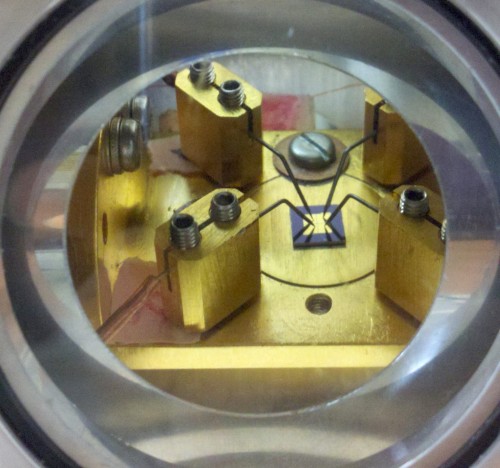 Testing Nanowires: A view through the optical port of the Janis ST-100 Cryostat.
Testing Nanowires: A view through the optical port of the Janis ST-100 Cryostat.Dr. Kim Michelle Lewis is working within the Physics Department to design molecular electronics. She has been working on techniques to use molecules to build electronic circuits. She received her Bachelor’s of Science in physics in 1998 from Dillard University in New Orleans. She then went on to receive her master’s in electrical engineering from the University of Michigan in 2003 and her doctorate in applied physics from the University of Michigan in 2004.
Lewis is using molecules to build electronic circuits by designing a two-terminal device (a source electrode and a drain electrode), and then connecting a molecule between the two terminals. Typically, this is done by connecting the two electrodes with a metal (e.g., copper, gold). However, in this case, she is using a molecule instead of metal. In return, the molecule is conducting electricity. Therefore, by applying a bias voltage, the current can be measured and the electrical properties of the molecule can be determined.
There is an array of applications that include molecular level transistors, diodes, and rectifiers. For example, a molecular diode allows the user to control the flow of current in only one direction. You can also create interconnects for integrated circuits for transporting charge. Her devices may also be designed to create a molecular switch to store information on the molecular level.
Lewis is focusing her research towards low-voltage applications (i.e., less than one volt). The circuits that she and her team creates could potentially be used for medical applications, such as pacemakers.
Recently, Lewis and her team have taken a look at a molecule called porphyrin, a perfectly symmetric molecule that can have at least two of its ends fractionalized with chemical groups that will allow the molecule to attach to metal. She and her team have observed that if these molecules are placed between a source and a drain, once a certain voltage is obtained, the molecules can switch to a higher conducting state. Therefore, it would potentially allow for them to store information at that state. At room temperature, they have found that this molecule can act this way. Currently, she is able to isolate single molecules in a circuit and then test single molecules.
Lewis entered this field of study because of the interdisciplinary aspect that it holds. Her work is both in the field of physics, understanding electron transport, while also allowing her to design electrical circuits, utilizing her degree in electrical engineering, and the field of chemistry, by engineering molecules to attach to certain metallic electrodes.
One of the end goals of Lewis’ research is to figure out how to stabilize the molecules. Currently, many aspects of the environment can affect the performance of the device, such as oxidation. In addition, many of these molecules are only stable at low temperatures, between four and 77 kelvin. She hopes to understand how the properties change with a function of temperature so that she can achieve room temperature applications. Lewis wishes to one day stabilize the molecules so that they function under all physical environments.
Lewis is leading exciting research related to low power applications. One day, her work may revolutionize the medical or semiconductor industry by producing molecular level circuits.
Additional information can be found on Professor Lewis’ website, http://www.poly.rpi.edu/89293 or on her Facebook page at http://www.poly.rpi.edu/95508.
